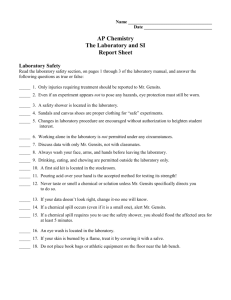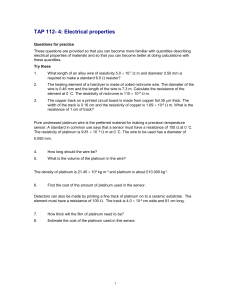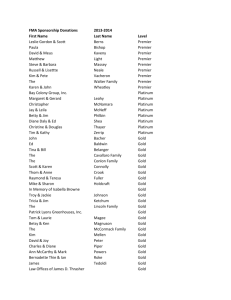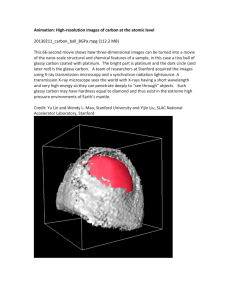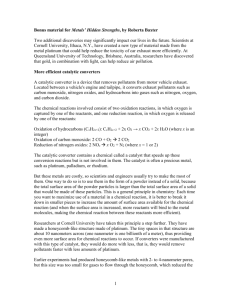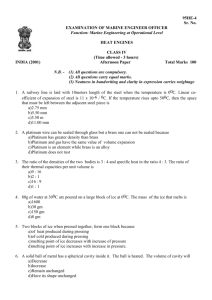Physical Sciences Grade 11 Teacher's Development Module
advertisement
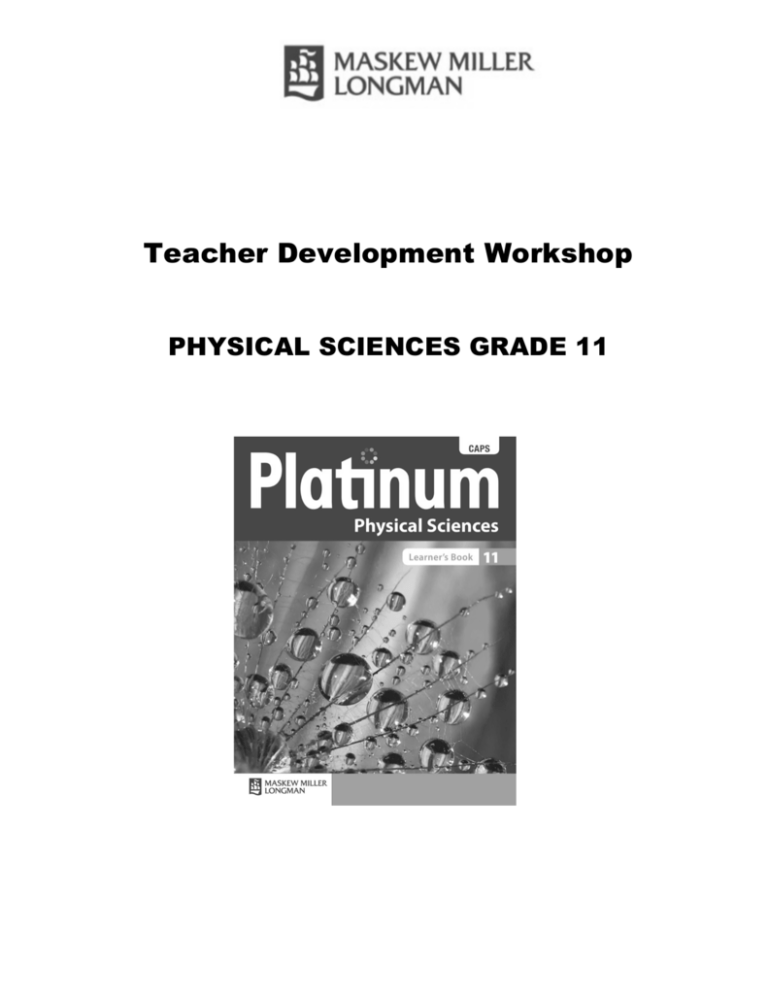
Teacher Development Workshop PHYSICAL SCIENCES GRADE 11 CONTENTS PAGE CONTENTS PAGE ....................................................................................................................................... 2 PROGRAMME OF ASSESSMENT FOR GRADE 11 .............................................................................. 4 EXAM REQUIREMENTS FOR GRADE 11 ............................................................................................. 5 TEACHING PHYSICAL SCIENCES GRADE 11 ...................................................................................... 6 ACTIVITY A: MOLECULAR SHAPE .............................................................................................................................. 6 ACTIVITY B: MOLECULAR SHAPE .............................................................................................................................. 8 ACTIVITY C: MOLECULAR STRUCTURE .................................................................................................................. 10 ACTIVITY D: MOLECULAR STRUCTURE ................................................................................................................. 12 HOW PLATINUM CAN HELP YOUR TEACHING. ............................................................................. 15 2 OVERVIEW OF GRADE 11 TOPICS AND SUBTOPICS IN PHYSICAL SCIENCES CAPS 3 PROGRAMME OF ASSESSMENT FOR GRADE 11 CAPS provides every subject with a detailed Programme of Assessment. The table below indicates the formal assessment task for the year for Grade 11 Physical Sciences. 4 EXAM REQUIREMENTS FOR GRADE 11 The information below provides a summary of the examination requirements for June and end-­‐of-­‐year examinations for Grade 11 Physical Sciences. Grade 11 Exams Time Marks Mid Year Examination 3 hours 300 Final examination 3 hours 150 Structure of Grade 11 Final Examination Paper 1 Physics A Mechanics Marks and Time guide 68 B Waves, sound and light 32 C Electricity and magnatism 50 Section Description Total 150 3 hours Structure of Grade 11 Final Examination Paper 2 Chemistry A Change Marks and Time guide 70 B Chemical systems 20 C Matter and Materials 60 Section Description Total 150 5 3 hours TEACHING PHYSICAL SCIENCES GRADE 11 Activity A: Molecular Shape This activity is taken from a Grade 11 Physical Sciences Topic. This example is given from Platinum Physical Sciences Grade 11. Topics to be covered: • Grade 11 Molecular Shape • Learning styles Instructions: • Participants should complete this activity in pairs. • Study the diagrams taken from Platinum Physical Sciences Grade 11. • Answer the questions that follow. 6 Taken from Platinum Physical Sciences (page 54-­‐55) Questions: 1. Why is it important to use visuals when teaching Physical Sciences? 7 Activity B: Molecular Shape This activity is taken from a Grade 11 Physical Sciences Topic. This example is given from Platinum Physical Sciences Grade 11. Topics to be covered: • Grade 11 Molecular Shape • Importance of understanding the information for future application. Instructions: • Participants should complete this activity in pairs. • Study the extract taken from Platinum Physical Sciences. • Answer the questions that follow. Taken from Platinum Physical Sciences (page 70) 8 Taken from Platinum Physical Sciences (page 71) Questions: 1. Physical Sciences requires a lot of practical demonstrations and tasks. Discuss the difficulties of large classes and lack of equipment and resources. 9 Activity C: Molecular Structure This activity is taken from a Grade 11 Physical Sciences Topic. This example is given from Platinum Physical Sciences Grade 11. Topics to be covered: • Grade 11 Molecular Structure • Importance of understanding the information for future application Instructions: • Participants should complete this activity in pairs. • Study the diagram taken from Platinum Physical Sciences Grade 11 • Answer the questions that follow 10 Questions: 1. Physical Sciences involves understanding of processes and practical application. How do you teach this section of work to ensure that the learners understand it? 11 Activity D: Molecular Structure This activity is taken from a Grade 11 Physical Sciences Topic. This example is given from Platinum Physical Sciences Grade 11. Topics to be covered: • Grade 11 Intermolecular Forces • Learning styles Instructions: • Participants should complete this activity in pairs. • Study the diagram taken from Platinum Grade 11 Physical Sciences. • Answer the questions that follow. 12 13 Questions: 1. The assessment experiment provided is an example of a formal assessment. Discuss which experiments should be used for formal assessment and which for informal assessment. 14 HOW PLATINUM PHYSICAL SCIENCES CAN HELP YOUR TEACHING The Platinum Physical Sciences book covers all of the criteria that are considered important to most teachers when choosing a textbook. Sequencing of Content according to the CAPS The Platinum Physical Sciences book follows the exact sequence of the CAPS. Teachers are able to follow the sequence of the textbook and be confident that they have covered everything required by CAPS, in the correct order. Relevant and up to date content The authors of Platinum Physical Sciences have ensured that the latest CAPS requirements are covered as well as the latest content required by the subject. Assessment tasks are all relevant to the age group and environments of the learners. Specific tasks required for Programme of Assessment e.g. Tests, Projects etc. The Platinum Physical Sciences book includes all the required tasks for the Programme of Assessment and the Teacher’s Guide includes all of the guidelines and answers. These can also be used for revision, extension and expanded opportunities. Annual teaching plan according to the CAPS with term-by-term overview The Platinum Physical Sciences book follows the exact sequence of the CAPS. It also provides a term planning tool, which assists in annual and quarterly planning. Teacher’s Guide, which provides assistance and answers for Programme of Assessment The Platinum Physical Sciences book has a Teacher’s Guide that provides guidelines on how to use the assessments and how to mark them. Rubrics, memoranda and checklists are also provided where appropriate. 15 Variety of revision activities The Platinum Physical Sciences book provides many different activities, which test knowledge and understanding on a variety of levels. Teachers are able to see the learners’ understanding of the content matter straight away. These activities are very practical and assess the content in the CAPS. Diagrams and pictures to explain content The Platinum Physical Sciences book has many supporting diagrams and pictures to support the content. The Platinum Physical Sciences Book in is full-­‐colour with eye-­‐ catching photographs. Remedial activities to support those learners that may need extra support The Platinum Physical Sciences book has many activities in the chapters as well as revision sections at the end of every topic. The Platinum Physical Sciences book also has remedial worksheets, which can be found in the Teacher’s Guide. Extension activities to support those learners that need expanded opportunities The Platinum Physical Sciences book has many activities in the chapters as well as revision sections at the end of every topic. The Platinum Physical Sciences book also has extension worksheets, which can be found in the Teacher’s Guide. Platinum Physical Sciences components: • Learner’s Book • Teacher’s Guide with Control Test Book and Question Bank CD 16


